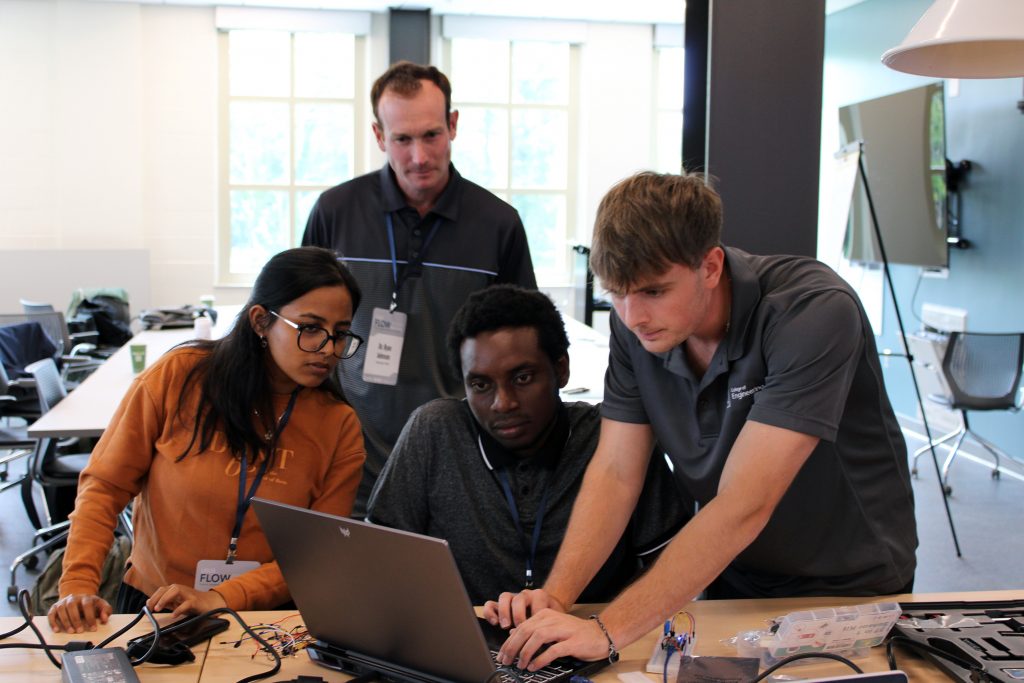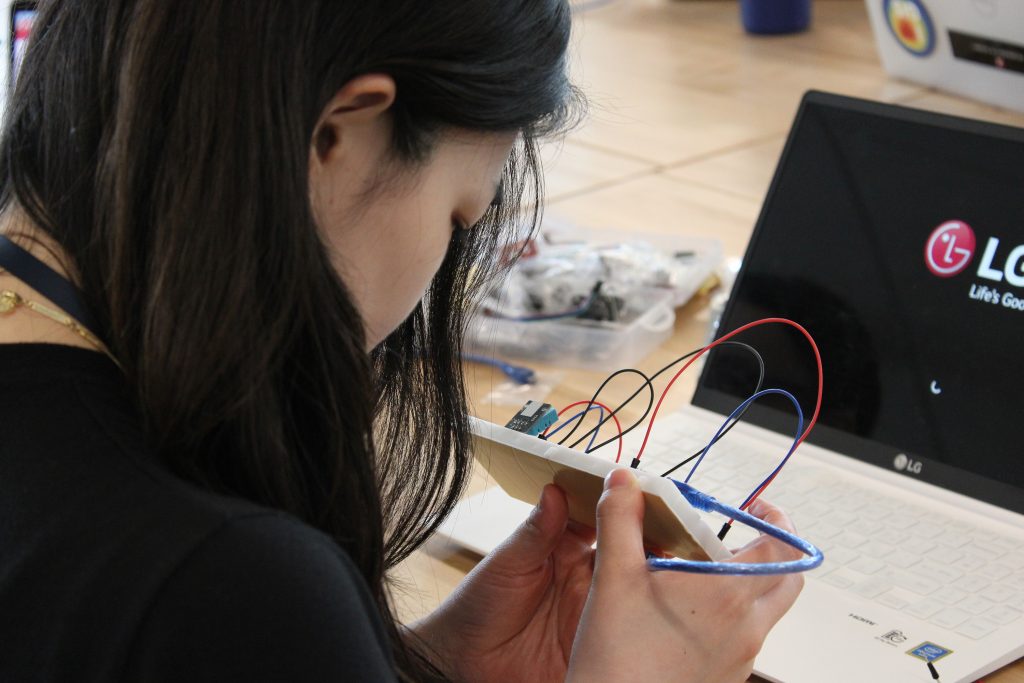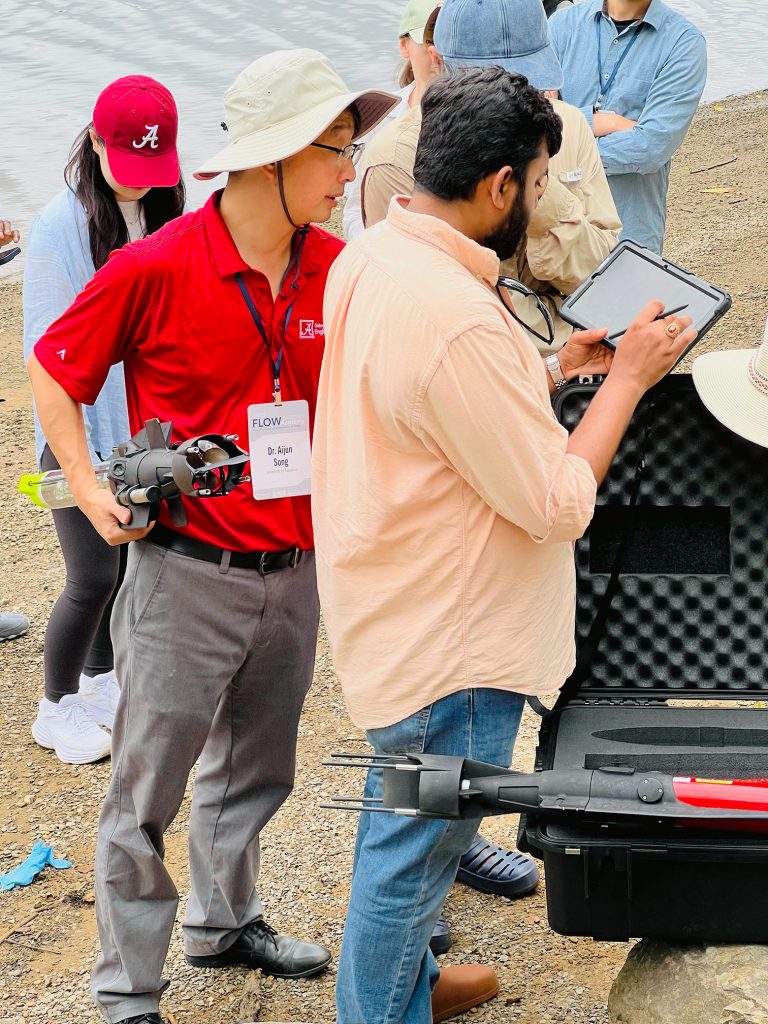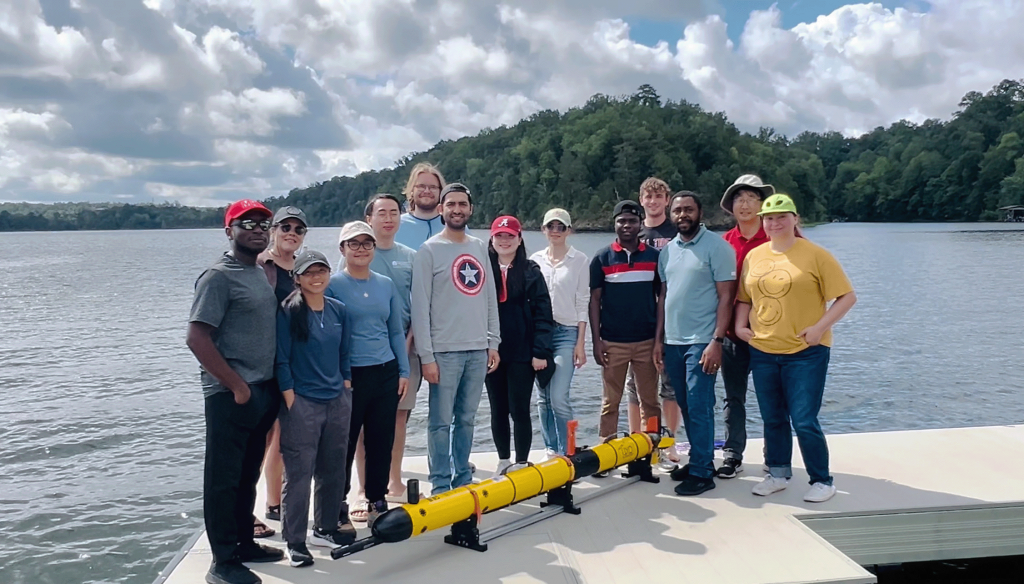TUSCALOOSA, Ala. — When 13 students arrived for the inaugural Future Leaders in Observation of Water Academy, or FLOW, in summer 2025, they entered uncharted territory. This first-of-its-kind program promised an intensive summer combining cutting-edge water technology, hands-on fieldwork and real-world problem-solving. What they didn’t anticipate was how completely the experience would transform their understanding of water science research.
FLOW represents an innovative partnership that brings together leading water researchers, federal partners and industry. Sponsored by the U.S. Geological Survey and organized by the Cooperative Institute for Research to Operations in Hydrology, or CIROH, the program is hosted by the Alabama Water Institute at The University of Alabama. Students work directly in the newly constructed Hydrologic Instrumentation Facility joining AWI and the NOAA National Water Center on a campus that water professionals and students are increasingly recognizing as WaterTown, USA.
“The USGS FLOW Academy is a unique, immersive, challenge-based, fieldwork-based research program for the summer,” said Dr. Lisa Davis, associate professor of Geography & the Environment at UA. “The emphasis on the FLOW Academy being sensor and technology-based measurements of water systems and for it to be a hands-on, somewhat field-based experience that would be taking place over the summer for a limited time and through collaboration with the USGS HIF.”
The program’s design addresses a critical need in water sciences by connecting undergraduate and graduate students with cutting-edge observing technologies and real-world research challenges while building professional networks that will define their careers.
FLOW Academy 2026
Applications now open for next summer’s program.
- Seven weeks
- Hands-on technology
- Field experiences
- Industry partnerships
- Learn more and apply
From Uncertainty to Excellence
The inaugural nature of the program created uncertainty for both organizers and participants. Students like Sara Gutierrez Diaz, a doctoral student in agricultural and environmental science engineering at Tuskegee University, discovered FLOW Academy while searching for summer opportunities that aligned with her interests in water science.
“I read it in a newsletter. Actually, I was keeping an eye out for the Summer Institute program, and then I read about FLOW, and it kind of fit in with what I wanted to do in the summer,” Gutierrez Diaz said. “The first week of FLOW Academy I was already extremely happy. I felt accomplished because on the first Tuesday we got hands-on training with a system that I had never used. I was like, this is what I can do.”
That immediate hands-on access set FLOW Academy apart. Rather than spending weeks in lectures before touching equipment, students began working with advanced sensors and technologies from day one.
For program organizers, the inaugural status meant planning without precedent.
“We really didn’t know what to expect,” said Davis. “We really sort of hoped for everything and planned for everything and really kind of exposed the students to a lot. It was very, very immersive, very intense, but also very fun.”
By summer’s end, both students and faculty agreed the program exceeded expectations. Godwin Sunday, a UA geological sciences, hydrology and geochemistry master’s student during the summer, summarized the sentiment.
“It exceeded my expectations tremendously,” he said.
Technology Access that Changes Everything
What distinguished FLOW Academy from traditional summer programs was immediate access to advanced hydrologic technology rarely available even to graduate students and established researchers.

“One of the really impressive things about FLOW Academy, from a water science perspective, is that students get to use a huge range of cutting-edge technology that they may not have access to in their day-to-day activities,” Davis explained. “Students or even researchers don’t have access to them.”
This unprecedented access transforms how students understand water science research. Instead of reading about sensor technologies in textbooks, they build them. Rather than watching demonstrations, they deploy equipment in rivers. The approach reflects a fundamental philosophy about learning and innovation.
“The whole idea is to translate the cutting-edge technology into water observation,” Dr. Aijun Song, associate professor in the UA Department of Electrical and Computer Engineering said. “We want the students to build things: hardware, instrumentation and software modules.”
Throughout the eight weeks, students progressed through increasingly sophisticated technologies. Day three brought soldering in the engineering lab, where students assembled circuit boards by hand. By day five, students toured the USGS HIF facility and participated in Arduino workshops, learning to program microcontrollers that power countless environmental monitoring systems. Dr. Ryan Johnson, a former postdoctoral researcher with AWI and CIROH, now an assistant professor of civil and environmental engineering at the University of Utah, led day nine’s Raspberry Pi session, introducing students to the credit card-sized computers that have revolutionized remote environmental sensing.
Cross-pollination of Ideas
The program deliberately assembled students from diverse academic backgrounds, recognizing that water science innovation requires both engineering expertise and scientific understanding.
“We wanted to pool students from traditional engineering fields, as well as students from the sciences and non-engineering fields and sort of blend those groups together to have complementary skills and knowledge sets that they can cross-pollinate with,” Davis explained.


This interdisciplinary approach proved essential as students organized into four teams tackling complex water monitoring challenges.
From Campus to River
The program balanced laboratory work with extensive field experiences that revealed the full spectrum of water science careers. On day 12, students worked with Song deploying autonomous underwater vehicles in the Black Warrior River.
Davis guided students through solar sensor deployments on day 15, demonstrating sustainable power solutions for remote monitoring stations. The work addressed a fundamental challenge in environmental monitoring: how to maintain sensors collecting data in locations without electrical infrastructure. Later, students learned acoustic Doppler current profiler techniques for measuring water velocity and flow, technology critical for understanding everything from flood forecasting to habitat assessment.

The partnership with USGS, led by Dr. Derek Bussan, chief for USGS Hydrologic Instrumentation Research and Operations, proved transformative for student learning.
“There were 13 students, four projects and they were the first students to take part at the HIF right here,” Bussan noted.
Connecting Research to Reality
The program’s industry partnerships extended student learning beyond academic research into commercial applications addressing real-world water challenges.
“We have two main industrial partners. One is Deep Analytics, and the other is Jaia Robotics,” Song said. “Deep Analytics provides stack assistance for monitoring stream flow using camera AI training. Jaia Robotics is an underwater robotics company. They provided latest Jaia units. Students use those robots, deploying in the field, collecting data, performing data analysis.”
These partnerships exposed students to career pathways beyond traditional academia, demonstrating how hydrologic research translates into commercial technologies that water managers, environmental consultants and government agencies use daily.
The Transformation Moment
After eight weeks of intensive learning and hands-on experience, students presented their team projects at the Tech Showcase. The event revealed how far participants had progressed from uncertain beginners to confident researchers capable of tackling complex water monitoring challenges.


Gutierrez Diaz’s reflection captured the transformation many students experienced.
“It was better than what I thought,” she said. “It’s been seven weeks of really hard work and seeing it today just full-on display, working. I think my expectations were just blown.”
The showcase wasn’t merely about technical achievements. For many students, it represented profound personal and professional growth.
“I’ve grown as a person, as a researcher, as a scientist,” Gutierrez Diaz said.
Sunday echoed this sentiment about the program’s community impact.
“It feels great, honestly. It feels wonderful,” he said.
Career Pathways Illuminated
For students uncertain about their future direction, FLOW Academy provided clarity and confidence. Gabby Tapat, a natural resources management undergraduate student at The University of Hawai’i Manoa, described the program’s transformative nature: “I would describe it as something definitely out of your comfort zone. If you want to learn something new, something exciting, I recommend this program.”
The program demonstrated how diverse academic backgrounds contribute to water science innovation, building student confidence regardless of their starting point. This inclusive approach challenges the misconception that water science research requires only traditional STEM backgrounds.
“I feel very humble and very proud,” Gutierrez Diaz reflected. “It is a once in a lifetime opportunity to be here and being chosen and being able to not only do everything but thrive in it.”
The Future of Water Science Starts Here
As water security challenges intensify globally, programs like FLOW Academy play increasingly critical roles in developing the next generation of hydrologic innovators. Climate change is altering precipitation patterns, population growth is stressing water supplies and aging infrastructure requires sophisticated monitoring to maintain safety. These challenges demand scientists who understand both cutting-edge technology and fundamental hydrologic principles.
The inaugural summer proved that combining hands-on technology training, interdisciplinary collaboration, field experiences and industry partnerships creates transformative learning experiences that prepare students for careers at the forefront of leading water research and operations.

The success of the 2025 cohort demonstrates what becomes possible when students gain access to cutting-edge facilities, expert mentorship from UA faculty and federal scientists, and real-world applications through industry partnerships. These 13 pioneers have set a standard of excellence that will define FLOW Academy for years to come.
The convergence of expertise at WaterTown, USA, creates unprecedented opportunities for undergraduate and graduate researchers. With AWI, CIROH, USGS and NOAA collaborating on the same campus, students don’t just learn about water science, they become part of the community shaping its future. They work alongside federal scientists, learn from faculty conducting cutting-edge research and connect with industry professionals developing next-generation monitoring technologies.
This ecosystem approach to education reflects a fundamental truth about 21st-century water science: solving complex water challenges requires collaboration across institutions, disciplines and sectors. FLOW Academy prepares students not just with technical skills, but with the professional networks and collaborative mindset essential for careers addressing society’s most pressing water security needs.
Applications for FLOW Academy 2026 are now open. The next cohort of future water science leaders is waiting to be discovered. The program seeks undergraduate and graduate students ready to challenge themselves, embrace interdisciplinary learning and contribute to solving real-world water monitoring challenges. Previous participants had diverse backgrounds—from engineering to geography, computer science to environmental science—united by curiosity about water systems and willingness to learn cutting-edge technologies.
Will you be among them? Learn more about FLOW Academy program details, eligibility requirements and application deadlines.
The FLOW Academy is an immersive program sponsored by the U.S. Geological Survey and organized by the Cooperative Institute for Research to Operations in Hydrology, focused on water observing sensors and technology for undergraduate and graduate students. Hosted by the Alabama Water Institute at The University of Alabama, the seven-week residential program provides students with hands-on experience in water observing technologies and professional development for careers in water sciences. The program includes small-team projects that address real-life research challenges in areas of data management, visualization, communication, and water sensing technology while utilizing the resources of the USGS Hydrologic Instrumentation Facility.